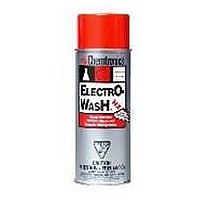ES1611 Chemtronics, ES1611 Datasheet - Page 3

ES1611
Manufacturer Part Number
ES1611
Description
CLEANER DEGREASER 12 OZ. CAN ELECTRO-WASH NX 141B FREE
Manufacturer
Chemtronics
Type
Degreaserr
Datasheet
1.ES1611.pdf
(4 pages)
Specifications of ES1611
Boiling Point
130 °F
Chemical Component
1, 1, 1, 2-Tetrafluoroethane/Carbon Dioxide/Ethanol/HCFC-225ca/HCFC-225cb/Methanol
Density, Vapor
7.0 (Air-1)
Dispensing Method
Aerosol
Evaporation
1 (Min.)
Odor
Faint Ethereal
Physical State
Liquid
Pressure, Vapor
289 mmHg @ 68° F
Primary Type
Cleaner
Solubility
Negligible
Special Features
Non-Flammable
Specific Gravity
1.55
Volatile
100 %
Weight
12 Oz.
Applications
Cleans Oil and Grease from Live Circuits
Product
Cleaners & Degreasers
Lead Free Status / Rohs Status
RoHS Compliant part
Hazardous Materials
ITW CHEMTRONICS
SECTION 1: CHEMICAL PRODUCT AND COMPANY IDENTIFICATION
Product Identification
Product Code: ES1611, ES2211
SECTION 2: COMPOSITION/INFORMATION ON INGREDIENTS
Chemical Name
HCFC-225ca
HCFC-225cb
Ethanol
Methanol
1,1,1,2-Tetrafluoroethane
Carbon Dioxide
SECTION 3: HAZARD IDENTIFICATION
Emergency Overview: Clear, colorless liquid with faint ethereal odor. This product is nonflammable. Liquid may irritate eyes and skin under repeated or prolonged
exposure. Breathing high concentrations of product vapor may produce dizziness and nausea.
Potential Health Effects:
Eyes:
Skin:
Ingestion: May be harmful if swallowed. Swallowing this material may result in nausea, vomiting and weakness followed by central nervous system depression.
Inhalation: Can be harmful if inhaled. High concentrations of vapors in immediate area can cause dizziness, nausea, vomiting, unconsciousness and death.
SECTION 4: FIRST AID MEASURES
Eyes:
and tested by medical personnel if irritation develops or persists.
Skin:
Ingestion: If swallowed, do not induce vomiting. If conscious, give 2 glasses of water. Never give anything by mouth to an unconscious person. Keep head below knees
to minimize chance of aspirating material into the lungs. Get medical attention immediately.
Inhalation: Remove to fresh air. If breathing is difficult, give oxygen. Get medical attention.
SECTION 5: FIRE FIGHTING MEASURES
Flash Point: None to boiling (TCC)
Extinguishing Media: Use water spray or fog, CO2, dry chemical or water stream when fighting fires involving this material.
Fire Fighting Instructions: As in any fire, wear self-contained breathing apparatus (pressure-demand, MSHA/NIOSH-approved or equivalent) and full protective gear.
SECTION 6: ACCIDENTAL RELEASE MEASURES
Spills: Shut off leak if possible and safe to do so. Absorb spill with inert material (e.g. dry sand or earth), then place in a chemical waste container for proper disposal.
Do not flush to sewer. Avoid runoff into storm sewers and ditches which lead to waterways.
SECTION 7: HANDLING AND STORAGE
Avoid prolonged or repeated contact with eyes, skin, and clothing. Wash hands before eating. Use with adequate ventilation. Avoid breathing product vapor or mist.
Do not reuse this container. Store in a cool dry place away from heat, sparks and flame. Do not store in direct sunlight.
KEEP OUT OF REACH OF CHILDREN.
SECTION 8: EXPOSURE CONTROLS/PERSONAL PROTECTION
Exposure Guidelines:
CHEMICAL NAME
HCFC-225 ca/HCFC-225 cb
Ethanol
Methanol
1,1,1,2-Tetrafluoroethane
Carbon Dioxide
* Supplier’s Occupational Exposure Limit
Work/Hygienic Practices: Good general ventilation should be sufficient to control airborne levels. If vapor concentration exceeds TLV, use NIOSH approved organic
vapor cartridge respirator. Wear safety glasses with side shields (or goggles) and rubber or other chemically resistant gloves.
NFPA and HMIS Codes:
Health
Flammability
Reactivity
Personal Protection
Liquid, aerosols and vapors of this product may be irritating and can cause pain, tearing, reddening and swelling accompanied by a stinging sensation.
Prolonged contact can cause skin irritation, including redness, burning, drying and/or cracking of skin..
Immediately flush with plenty of water. After initial flushing, remove any contact lenses and continue flushing for at least 15 minutes. Have eyes examined
Wash skin with soap and water. Remove contaminated clothing. Get medical attention if irritation develops or persist. Wash clothing before reuse.
®
Product Information: 800-TECH-401
New & Improved Electro-Wash® NX
ACGIH TLV
not established
1000 ppm
200 ppm
not established
5000 ppm
CAS#
NFPA
Page 1 of 2
422-56-0
507-55-1
64-17-5
67-56-1
811-97-2
124-38-9
1
0
1
-
not established
OSHA PEL
1000 ppm
200 ppm
5000 ppm
not established
Wt. % Range
HMIS
20.0-40.0
20.0-40.0
10.0-30.0
1.0-5.0
2.0-4.0
0.1-1.0
1
0
1
B
OTHER
100 ppm*
1000 ppm*
30,000 ppm STEL
MSDS #1611



